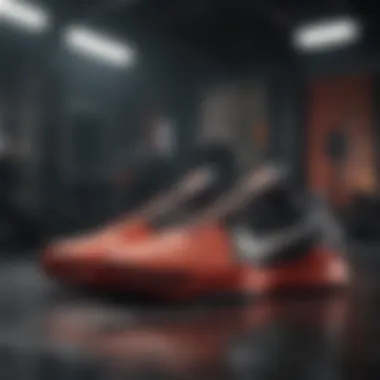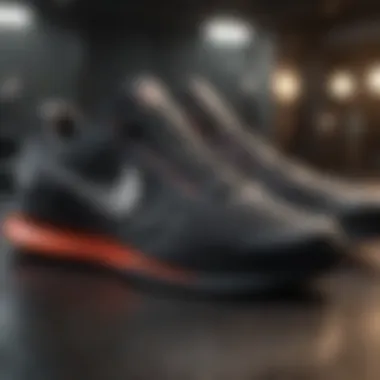Nike Shoes for Weight Training: A Comprehensive Guide


Intro
Weight training requires specific footwear to ensure optimal performance and avoid injury. Nike offers various shoe models designed to meet the unique demands of weightlifting and resistance training. These shoes feature advanced technology that provides support, stability, and comfort during workouts. With a multitude of options available, it can be challenging for fitness enthusiasts to select the right pair.
This guide aims to illuminate essential features, benefits, and considerations surrounding Nike shoes tailored for weight training. It will also detail how different models cater to distinct training modalities and personal preferences. In doing so, it empowers readers to enhance their weight training experience through informed footwear choices.
Understanding Weight Training Footwear
Weight training requires more than just determination and a good workout plan. It necessitates the right footwear to support performance and ease of movement. Nike shoes specifically designed for weight training marry style with functionality. They help prevent injuries and provide a stable base for lifting. Choosing the right shoes can significantly enhance one's experience in strength training.
Importance of Appropriate Footwear
Appropriate footwear plays a crucial role in weight training. Without the right shoes, performance can be compromised. Poor shoe choice can lead to correct posture and balance. Proper footwear provides necessary support, which is essential when performing heavy lifts or complex movements. Inadequate shoes can lead to discomfort and potential injuries, affecting workout consistency.
Key Features of Weight Training Shoes
To ensure effectiveness during training, weight training shoes should possess specific features. Each characteristic contributes fundamentally to performance and safety. The following key features are vital:
Stability
Stability in weight training shoes enables a solid ground for lifting. A stable base aids in maintaining balance and coordination during exercises like squats and deadlifts. A key characteristic of stability is a firm outsole. This type of shoe minimizes foot movement inside the shoe. Consequently, it provides better control during workouts. Stability is beneficial as it significantly reduces the risk of injuries.
Support
Support is another essential element in weight training shoes. It is directly related to foot and ankle safety. The right shoes should offer arch support and cushioning, which can mitigate stress on the feet. This feature helps in distributing weight evenly across the foot. This can enhance overall comfort during longer training sessions. Supportive footwear can also reduce fatigue and improve performance.
Traction
Traction is critical for preventing slips or falls during exercise. Shoes with high traction allow for solid grip on the gym floor, even when performing vigorous movements. A key characteristic of effective traction is the outsole design, which enhances grip. Adequate traction fosters confidence when executing heavy lifts, making it a popular choice amongst weight trainers. Poor traction, on the other hand, can lead to accidents and disrupt workouts.
Breathability
Breathability refers to the shoe's ability to allow air circulation. This feature helps keep the feet dry and comfortable, even during intense workouts. A key characteristic of breathability is mesh materials used in the construction of the shoe. This ensures a cooler environment for the feet, leading to enhanced comfort. Breathable shoes can prevent overheating and moisture buildup, reducing the risk of blisters.
Choosing the right weight training footwear is vital. It can make a considerable difference in comfort, performance, and safety during workouts.
Overview of Nike Shoes for Weight Training
When it comes to weight training, the choice of footwear plays a crucial role in performance. Understanding Nike shoes designed specifically for this purpose can provide significant advantages. Nike has built a reputation for innovation and performance in athletic footwear, making it important to explore how their shoes cater to weight training needs.
Nike's offerings in weight training footwear are not merely an accessory; they are a fundamental component that can influence training effectiveness. These shoes are engineered with specific features that address the demands of lifting, stability, and comfort. Weight training requires a stable base, and the right shoe can enhance your performance by ensuring proper foot positioning during exercises.
Choosing the right footwear can also reduce the risk of injury. A well-designed shoe offers support and cushioning that aligns with the movements and stresses involved in weightlifting.
Nike's Reputation in Athletic Footwear


Nike has established itself as a leader in athletic footwear. The brand is recognized worldwide for its commitment to quality and performance. Customers trust Nike shoes due to their innovative technologies and attention to detail, which come together to support athletes across various disciplines.
From professional athletes to casual gym-goers, Nike shoes deliver both style and substance. The company continually invests in research to develop footwear that meets the specific needs of different sports, including weight training. This dedication has solidified Nike's reputation as a go-to brand for serious athletes looking to optimize their training.
Historical Context of Nike in Weight Training
Nike entered the weight training footwear market with a clear vision: to enhance the lifting experience. Over the years, the brand introduced several models aimed at providing hypertained support and stability needed during intense workouts. Specific innovations such as the Nike Metcon and the Romaleos lines were designed to meet this goal.
The historical evolution of Nike in weight training showcases its adaptability to emerging training techniques and athlete feedback. These innovations reflect a keen understanding of the competitive fitness landscape, allowing Nike to maintain relevance. As fitness methodologies evolve, so too have Nike's weight training shoes, ensuring they remain aligned with the needs of all types of lifters.
In summary, Nike's commitment to producing high-quality weight training footwear is evident through its ongoing innovations and a strong historical presence in the market. The brand's reputation and the development of specialized models highlight the significance of appropriate footwear in enhancing weight training performance.
Popular Nike Models for Weight Training
Selecting the right footwear is fundamental in optimizing performance during weight training. Nike offers a variety of options tailored specifically for different types of training, each with its unique attributes that cater to various needs. Understanding these models can assist trainers and fitness enthusiasts in making informed choices that align with their goals and training styles. This section provides an in-depth examination of popular Nike models for weight training, emphasizing their distinctive features and user experiences.
Nike Metcon Series
Features and Benefits
The Nike Metcon series stands out for its versatility and durability. It is engineered for high-intensity training, providing stability and support for various exercises. One of the key benefits is the strong heel, which reinforces the base during heavy lifts. This enhances balance and reduces the risk of injury. Users often praise the traction that is ideal for dynamic movements.
Another noteworthy feature is the breathable upper material. This allows for adequate airflow, keeping feet cool during intense workouts. Overall, the Metcon series is a popular choice because it combines performance with comfort, necessary for complex training regimens.
Best Use Cases
The Metcon series is best suited for athletes engaged in functional fitness and high-intensity interval training (HIIT). Its design accommodates weightlifting, sprinting, and other dynamic movements, providing a stable platform for versatility. Users highlight its effectiveness for varied workout routines, which makes it a beneficial choice for those who prioritize a multifaceted training approach.
However, some users note that while the shoe excels in many areas, it may not offer enough cushioning for long-distance running, which is something to keep in mind depending on individual training preferences.
User Reviews
User feedback on the Metcon series has been overwhelmingly positive, with many emphasizing its durability and performance. Reviewers often mention the great support during heavy lifts, and the shoe's ability to transition between different types of training seamlessly. The general consensus is that it meets the needs of serious athletes.
Nonetheless, some users report a tighter fit, which may not appeal to everyone. This aspect could be a consideration for those with wider feet.
Nike Romaleos Series
Design and Engineering
The Nike Romaleos series is recognized for its specialized design aimed at power and Olympic lifting. The shoe features a firm sole that offers optimal stability and reduces the risk of power loss during lifts. Reviews emphasize that the supportive straps enhance lockdown, ensuring that the foot stays secure. This feature is essential for maximizing lifting performance.
The design is both functional and aesthetically pleasing, merging performance with style. Users appreciate the careful engineering that goes into providing a customized fit for athletes focused on lifting.
Performance in Olympic Lifting
When it comes to Olympic lifting, the Romaleos series excels. It delivers excellent support, allowing for maximum power transfer during lifts. Many athletes report significant improvements in their performance after switching to Romaleos, citing enhanced stability and comfort during their lifts. Its raised heel is another key characteristic that aids in achieving better squat depth.


On the downside, the rigid design may be less suitable for mixed-use training or cardio-focused workouts. This limitation makes it less versatile than some other models but essential for dedicated weightlifters.
Comparison with Other Models
In comparison to other Nike models like the Metcon, the Romaleos show a clear advantage in terms of support specifically for heavy lifting. The unique combination of a solid base with a raised heel distinguishes it from other options. This specialized function is particularly beneficial for serious lifters.
However, it does come with a higher price point, which may not be justified for casual weight trainers.
Nike Free Metcon
Flexibility and Comfort
The Nike Free Metcon models focus heavily on flexibility without sacrificing support. Users often highlight the adaptability it offers for various types of workouts. The design includes a softer forefoot that allows for greater range of motion, accommodating diverse fitness routines.
This combination of stability and flexibility makes it an appealing option for those who engage in both strength and cardio training. The feedback supports its dual functionality, proving advantageous for trainers looking for a one-shoe solution.
Versatility for Various Workouts
One of the main uses for the Free Metcon is its versatility. It performs well in both weightlifting and cardio. This model is highly praised for maintaining grip on various surfaces, which allows for a seamless transition between different workout types. Users have found it to be a fantastic choice for circuit training and CrossFit workouts.
The trade-off, however, could be with stability during extremely heavy lifts; some may find it not as secure as more rigid models.
User Feedback
User reviews indicate satisfaction with the Free Metcon's comfort and performance. Many appreciate its lightweight feel, which allows for extensive movement without feeling hindered. However, some users report issues with durability over time, especially with the upper materials. This potential drawback might require users to consider how often they train and the intensity of their workouts.
Technological Enhancements in Nike Footwear
Technological advancements within Nike footwear significantly influence weight training experiences. These enhancements are crucial as they merge comfort, performance, and support, fostering a better training environment. Understanding the specific technologies can aid trainers and athletes in selecting the most advantageous footwear for their routines.
Flyknit Technology
Flyknit technology represents a key innovation for Nike, especially in weight training shoes. This construction method uses high-strength fibers woven into a single layer. The result is a shoe that is both lightweight and form-fitting, adapting to the wearer's foot shape. This level of customization offers more freedom of movement.
Benefits of Flyknit technology include:
- Lightweight design: The absence of traditional shoe panels decreases weight, which can enhance agility during workouts.
- Breathability: The material allows for airflow, reducing heat buildup and sweat.
- Flexibility: It offers a natural range of motion. As athletes perform various weight training exercises, a flexible shoe can conform with their movements.
Considering these aspects, Flyknit technology enhances comfort without compromising support. It enables athletes to focus on their performance rather than on distractions caused by inadequate footwear.
Zoom Air Cushioning
Zoom Air cushioning is another standout feature in many Nike weight training shoes. This technology incorporates air units into the shoe sole, allowing them to compress and expand as needed during activity. The cushioning effect provides a responsive feel, resulting in a spring-like effect during movements.
Key advantages of Zoom Air cushioning include:
- Impact protection: It mitigates stress on knees and joints while performing heavy lifts or intense workouts.
- Responsiveness: The ability to provide energy return enhances explosiveness, valuable for dynamic lifting and movement tasks.
- Stability: Shoes equipped with this technology tend to offer a balanced support system, crucial during lifts requiring precision.


In weight training, the importance of cushioning cannot be overstated. A well-cushioned shoe can enhance performance and reduce injury risk. The specialized technology behind Nike's footwear not only prioritizes comfort but also enhances the overall training experience.
"Understanding shoe technology can be pivotal for optimizing an athlete's performance."
Selecting the Right Nike Shoes for Weight Training
Choosing the right shoes is crucial for anyone engaged in weight training. This decision impacts performance, safety, and overall training experience. Nike offers a range of footwear specifically designed to support various training needs. This section assesses how to select the best Nike shoes tailored to individual requirements.
Assessing Personal Training Needs
Understanding personal training goals is the first step in selecting appropriate footwear. Different training styles, whether it be powerlifting, bodybuilding, or general strength training, demand different shoe characteristics.
For those focusing on heavy lifting, shoes with a flat sole and firm heel, like the Nike Romaleos, provide the stability needed for optimal performance. Conversely, if agility and versatility are priorities, the Nike Metcon series may be more suitable due to their multi-functional design. Each workout regimen has distinct challenges and requirements which must be considered when assessing your needs.
Sizing and Fit Considerations
A proper fit is paramount for effective performance in weight training. Nike’s shoes generally provide a varied range of sizes and widths. It is essential to try on several models to find the ideal fit. Pay attention to both length and width to avoid discomfort during exercises.
Here are a few pointers when choosing the right size:
- Try Shoes On: Always test shoes with the type of socks you intend to wear during workouts.
- Heel Lock: Ensure your heel does not slip out while performing lifts; this can lead to instability.
- Toe Space: Check that your toes have enough room—not too tight and not too loose.
Fit impacts not only comfort but also performance, making it a crucial element when selecting Nike shoes.
Budgeting for Quality Footwear
Investing in quality weight training shoes can significantly affect your performance and comfort. While Nike offers shoes across a spectrum of prices, finding a model that balances quality and budget is essential.
Consider these factors when budgeting:
- Functionality versus Cost: Higher-priced models often include advanced technology and materials, which can enhance performance.
- Longevity and Durability: Evaluate how long you intend to use the shoes. Investing more initially can yield better long-term results, saving you money over time.
- Available Discounts: Keep an eye for seasonal sales or outlet options that offer quality shoes at a reduced price.
"Quality footwear is not just an accessory; it is a vital component of an effective training regimen."
In summary, choosing the right Nike shoes for weight training necessitates a careful evaluation of personal goals, a proper fit, and a sensible budget. Each of these considerations plays a critical role in ensuring that your training is both productive and enjoyable.
Culmination
In the discussion of Nike shoes for weight training, it is vital to recognize the comprehensive landscape that exists around proper footwear selection. Weight training is not merely a physical activity; it is a science and an art that requires precision, commitment, and the right tools. Shoes are a critical element in this equation, acting as a foundation for performance and safety.
Summary of Key Insights
The article has detailed various aspects of Nike shoes tailored for weight training. We examined the importance of appropriate footwear and key features that enhance training performance such as stability, support, and traction. Each model, from the Metcon series to the Romaleos and the Free Metcon, offers distinct characteristics that serve different training needs. Furthermore, technological advancements like Flyknit technology and Zoom Air cushioning enhance comfort, durability, and overall performance, ensuring a better workout experience.
Footwear plays a significant role in weight training, affecting both performance and injury prevention.
As we explored the nuances of different Nike models, it became clear that personal training needs, sizing, fit, and budgeting are crucial considerations to make the best choice. Understanding these facets allows individuals to select footwear that not only meets their requirements but also aids in achieving their fitness goals effectively.
Encouragement for Informed Choices
As we conclude, it is crucial to emphasize the importance of making informed decisions regarding weight training footwear. Nike provides a rich selection of shoes tailored for various training modalities. However, personal preferences and specific training styles will dictate the best fit. Fitness professionals, wellness coaches, and dedicated enthusiasts should pay attention to each shoe's traits and how they align with their specific needs. Investing in high-quality shoes is not just about expenditure; it is an investment in one's training longevity and success. By prioritizing research and understanding, individuals can avoid common pitfalls associated with inappropriate footwear.
In essence, armed with the insights from this article, readers are encouraged to evaluate their training environment, analyze the features of different Nike shoes, and make choices that enhance their performance while ensuring safety.







